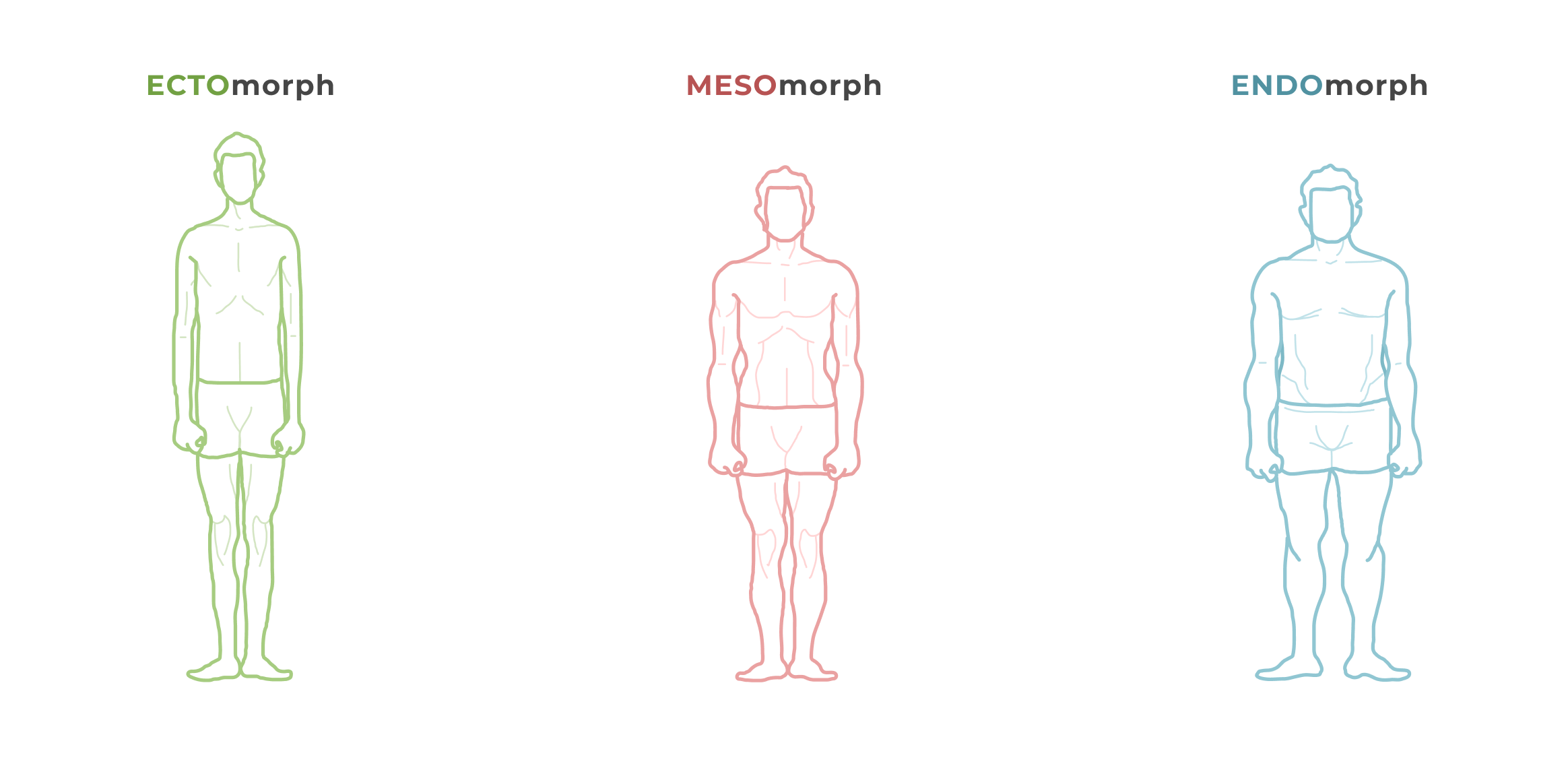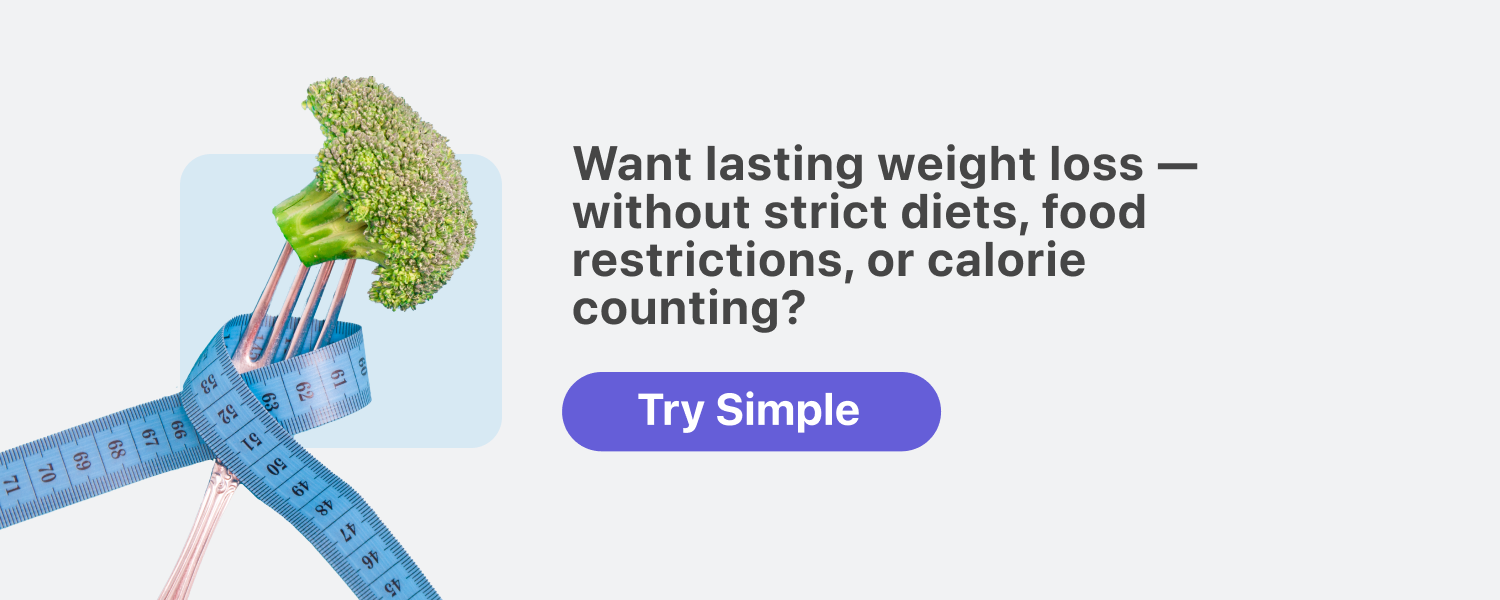Simple’s top intermittent fasting schedules by body type

Look around, and you’ll notice immediately that people are different. Humans vary widely in their shapes and sizes, from the barely-five-foot-tall populations in Indonesia and Bolivia to the easily-six-foot-tall folks of places like the Netherlands and Montenegro.

Watch the Olympics, and you’ll see diverse body types excelling at different sports: tiny bodies flying through the air in gymnastics, long bodies slicing through the water in swimming, and thick bodies hurling heavy objects through the air.
It seems obvious: people come in different packages.
But how much does body type actually matter? Is there science to support it? And should you adjust your intermittent fasting approach according to your body type?
In this article, we’ll explore body type and whether there are optimal intermittent fasting methods for each body type.
What are the different body types?

Back in the 1940s, a psychologist named William Herbert Sheldon came up with somatotype theory — the idea that people can be sorted into different body types.[1]
He proposed the following groups:
Ectomorph: Ectomorphs are typically leaner and lankier, with longer limbs and a narrower frame. It’s often hard for these body types to gain weight or muscle. They often have low body fat and may find it difficult to develop significant muscle mass.
Mesomorph: Mesomorphs are often considered the more muscular body type. They tend to have a naturally athletic build with broader shoulders, a narrow waist, and good muscle definition. Mesomorphs can gain and lose weight relatively easily and have an easier time building muscle mass.
Endomorph: Endomorphs are typically characterized by a softer, rounder physique. They often have a wider, denser frame with more body fat, particularly around the midsection. Endomorphs often find it easier to gain weight but more challenging to lose it. They may also find it harder to build muscle mass as well.
In the years since Sheldon’s original proposal, scientists have developed many other highly detailed classifications to try to figure out how to organize human beings.[2,3] A later 7-point method used weight, height, the breadth of thigh and arm bones, calf circumference, and body fat skinfold measurements from the triceps, shoulder blades, hips, and calves.[2]
Most of Sheldon’s ideas have since been debunked and heavily criticized — especially the link he proposed between body type and people’s character.[4,5,6]
However, it is clear that humans do vary in many features, such as:
- height
- bone density
- skeletal shape
- muscle mass (and how easy or hard it is to gain)
- body fat (and how easy or hard fat loss is)
Each individual person is a combination of features, so very few people are clearly “types.” Most of these features can change with age, and we can influence many of them with our behaviors. (More on this in a moment.)
That said, sports science researchers have explored whether particular body features help performance in specific sports, and it’s clear that different body types are better adapted to different activities, especially at elite levels of competition.[7,8,9]
But, again, does this matter — especially for “regular people” who just want to lose weight or improve their health?
Are there different intermittent fasting approaches based on body type?

Best intermittent fasting schedules according to body type
Just like there are many different body types, there are many types of intermittent fasting, each with its own pros and cons.
At Simple, the approach we recommend most is time-restricted eating, or TRE. With this method, you fast for several hours, most likely overnight, then enjoy an “eating window” of normal eating. There are many types of TRE schedules, such as:
- 12:12 (12 hours fasting + 12 hours eating)
- 14:10 (14 hours fasting + 10 hours eating)
- 16:8 (16 hours fasting + 8 hours eating)
The flexibility of TRE makes it an ideal approach for all body types. So, should you be “fasting for your body type”? Heck, is there some kind of “intermittent fasting according to body type test” you can take? (Spoiler: Not really.)
Let’s explore how you might modify the basic TRE method.
Ectomorph
The classic ectomorph tends to have trouble gaining muscle mass but loses weight easily. If that’s you, you might find that intermittent fasting is a natural fit for your existing lifestyle habits.
Intermittent fasting for this body type involves balancing a fasting lifestyle with getting proper nutrition to support overall well-being. Make sure you’re eating enough calories in your eating window, and your fasting window isn’t too long.
Consider keeping your fast to 16 hours or less if your goal is better health rather than weight loss.
For more on balancing fasting and good nutrition, see what to eat during intermittent fasting.
Mesomorph
The classic mesomorph gains muscle mass relatively easily but might put on a little extra body fat. The good news is that with the right fasting schedule, you can maintain that muscle mass while trimming down.
Focus on getting plenty of protein in your eating window to preserve those buff biceps, and enjoy revealing your athletic physique as the body fat melts off. (Your Simple app can help you with individualized recommendations and even high-protein recipe ideas via our wellness assistant Avo.)
Intermittent fasting for this body type is open-ended: You’ll likely do fine with a range of approaches, so feel free to experiment with everything from 12:12 to 16:8.
Endomorph
The classic endomorph gains body fat relatively easily and often finds it hard to get leaner. Folks in this group may have felt frustrated and deprived after years of traditional dieting and may have wondered, is it even possible for me to lose body fat or maintain a healthy weight?
Fasting to the rescue: Intermittent fasting for this body type gives endomorphs a much-deserved break from the diet roller coaster by providing a flexible lifestyle that optimizes metabolism and improves health, rather than a traditional diet that just cuts calories (among other restrictions).
If this is you, explore longer fasts (such as 16:8), as these are correlated with better weight loss.[10] Remember, though, to avoid fasting for periods beyond 18 hours, as there is limited research to show any additional benefits. And check out what to eat during intermittent fasting to learn more about this flexible approach.
Not sure which intermittent fasting schedule to choose? We’ve got you covered! Take our Simple quiz, and we can help you figure out the best schedule for your unique body, preferences, and lifestyle. Take the first step to understanding your body type and get personalized insights now!
How does intermittent fasting affect body type?

Intermittent fasting won’t change your body type per se. In other words, you’re not going to get magically taller or turn into a lithe gymnast after a long career as a sumo wrestler.
However, intermittent fasting can help with weight loss and fat loss — especially if you combine it with regular exercise and healthy nutrition during your eating window. For instance, intermittent fasting may help you to lose belly fat, as well as body fat in other areas.
This can affect how your body type appears — for example, if you use intermittent fasting to shed body fat, it can expose all that muscle mass that you worked hard in the gym to build. You’ll look like a mesomorph, even if you weren’t born that way.
Benefits of intermittent fasting on the body
Intermittent fasting has many benefits. (See here for more.)
Weight loss: Fasting usually means eating less overall, which can help people lose weight without feeling deprived or having to “go on a diet.” Longer periods of fasting and shorter eating windows (such as 16:8) seem to help the most for folks like endomorphs.[2–4]
Metabolic health: Intermittent fasting improves many indicators of metabolic health, such as:[5–7]
- insulin sensitivity, or how responsive your cells are to insulin — which means better blood sugar management
- markers of heart health, such as blood pressure or better cholesterol levels
Brain health: Intermittent fasting is increasingly being studied for its effects on the brain, nervous system, and cognitive function.[8] Ectomorphs are often more likely to say they feel more mentally “switched on” while fasting.
Mindful eating and hunger awareness: Many people find they’re more aware of their hunger cues when they fast, which helps them eat more intuitively (a lovely relief for anyone who’s struggled with their relationship with food).
If all of these benefits have you eager to get started, why not head over to our Simple quiz? You’ll be able to set your fasting schedule exactly how you want and get some practical ideas to support you as you start your wellness journey.

Who should avoid intermittent fasting?
Intermittent fasting is safe for beginners and experienced fasters alike. While intermittent fasting does have a few side effects, most healthy adults will do fine with fasting, no matter what their body type. This is especially true if they’re careful to avoid some common intermittent fasting mistakes.
However, fasting is NOT a good option for folks who:
- are pregnant or breastfeeding
- are under the age of 18, or 80 years old or more
- have been diagnosed with an eating disorder, have disordered eating tendencies, and/or have a history of this
- have a medical condition (or are taking medication) that makes fasting unsafe
- need a lot of calories every day (such as elite athletes doing hours of exercise)
Does exercise have an impact on your body type?
Yes and no. As adults, we can’t change our genes or the shape of our skeleton. However, we can build muscle mass — at any age. Plus, exercise can support weight loss, trim body fat, improve insulin sensitivity, and lower blood pressure.[11]
Over time, if we’re consistent with physical activity, we can achieve and maintain a body that might not look anything like our favorite fitness influencer but rather a fit version of ourselves with our unique body type.
Resistance training, in particular, can help build and maintain muscle mass and bone density that improves overall body composition (our ratio of lean mass to body fat).[12] Having a healthy body composition is strongly linked to feeling and functioning well throughout our lives, especially as we age.[13]
Of course, the most important exercise is the one you’ll enjoy and do regularly!
And your workouts should fit your fitness level and health. Talk to a fitness coach or doctor if you’re not sure what exercises are best for you. To get started, here are our tips on intermittent fasting and working out.
Pro tip: Make sure you stay hydrated while exercising and fasting! Learn more about what to drink while intermittent fasting.
Simple’s tips on practicing intermittent fasting for your body type

Recognize that you’re a unique individual.
You’re more than just a body type. And there’s no one-size-fits-all recipe for the “perfect” fasting schedule.
Bodies change with lifestyle, age, and behaviors. Intermittent fasting for body types is just one part of the equation — and you may discover that general recommendations don’t fit YOU. That’s OK!
Experiment and find what does align with YOUR individual body, routine, preferences, and needs.
Follow good basic fasting habits.
While scientists may eventually discover the ideal intermittent fasting approach based on body type, we do know that having good basic fasting and lifestyle habits is the recipe that makes the magic for health, longevity, and weight loss.
This includes making healthy nutrition choices during your eating window and making sure to stay hydrated to combat hunger and replace fluids. (Learn more about what you can drink during fasting.)
Embrace your body type.
You may have more body fat or less muscle mass than you’d prefer. You may want to improve some lifestyle habits or hope to live a long and healthy life. All of that is OK!
And, as you continue to use your Simple app, we’ll help you practice all those little daily actions — including intermittent fasting — that get you feeling and functioning better than you ever imagined.
At the same time, it’s important to begin by accepting YOUR unique physiological makeup and working with that rather than fighting against it.
Look for activities where your body type thrives and excels, and explore the possibilities of what your body can do — rather than focusing on what it can’t.
Frequently asked questions about intermittent fasting by body type
Muscular mesomorphs are often able to lose weight more easily because they have more lean mass, which burns more calories at rest than fat. They also tend to gravitate towards being physically active.
It’s not a “get out of jail free” card, though! Like everyone else, mesomorphs need to eat well and exercise regularly to lose weight and keep it off.

- Sheldon WH, Stevens SS, Tucker WB. The varieties of human physique. 1940;347.
- Rempel R. A modified somatotype assessment methodology [Internet] [MSc]. Simon Fraser University; 1994 [cited 2023 Nov 7].
- Carter JEL, Heath B. Somatotype methodology and kinesiology research. Kinesiology Review. 1971;10(9):10–9.
- Vertinsky P. Embodying Normalcy: Anthropometry and the Long Arm of William H. Sheldon’s Somatotyping Project. J Sport Hist. 2002;29(1):95–133.
- Vertinsky P. Physique as destiny: William H. Sheldon, Barbara Honeyman Heath and the struggle for hegemony in the science of somatotyping. Can Bull Med Hist. 2007;24(2):291–316.
- Ramachandran A, Vertinsky P. Speaking back to Sheldon: Barbara Honeyman Heath as the new “doyenne of somatotyping.” Cult Hist. 2022 Apr;11(1):49–69.
- Kerr DA, Ross WD, Norton K, Hume P, Kagawa M, Ackland TR. Olympic lightweight and open-class rowers possess distinctive physical and proportionality characteristics. J Sports Sci. 2007 Jan 1;25(1):43–53.
- Sánchez-Muñoz C, Sanz D, Zabala M. Anthropometric characteristics, body composition and somatotype of elite junior tennis players. Br J Sports Med. 2007 Nov;41(11):793–9.
- Lewandowska J, Buśko K, Pastuszak A, Boguszewska K. Somatotype variables related to muscle torque and power in judoists. J Hum Kinet. 2011 Dec;30:21–8.
- Welton S, Minty R, O’Driscoll T, Willms H, Poirier D, Madden S, et al. Intermittent fasting and weight loss: Systematic review. Can Fam Physician. 2020 Feb;66(2):117–25.
- Thyfault JP, Bergouignan A. Exercise and metabolic health: beyond skeletal muscle. Diabetologia. 2020 Aug;63(8):1464–74.
- Lopez P, Taaffe DR, Galvão DA, Newton RU, Nonemacher ER, Wendt VM, et al. Resistance training effectiveness on body composition and body weight outcomes in individuals with overweight and obesity across the lifespan: A systematic review and meta-analysis. Obes Rev. 2022 May;23(5):e13428.
- Khodadad Kashi S, Mirzazadeh ZS, Saatchian V. A Systematic Review and Meta-Analysis of Resistance Training on Quality of Life, Depression, Muscle Strength, and Functional Exercise Capacity in Older Adults Aged 60 Years or More. Biol Res Nurs. 2023 Jan;25(1):88–106.
